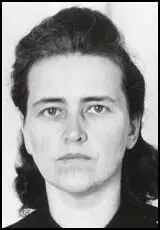Elise Hampel

Elise Lemme was born in Bismark, Germany, on 27 October 1903. After finishing elementary school she worked as a domestic servant. She married Otto Hampel in 1935. Elise Hampel joined the National Socialist Frauenschaft (Women's League) in 1936, leading a group until 1940.
Elise Hampel changed her views on Adolf Hitler after her brother's death during the German assault on France. Opposed to what she now believed to be a war of aggression she began writing anti-Nazi postcards and leaflets and leaving them in mailboxes. They urged people to refuse to serve in the war and to overthrow Hitler.
The Hampels were arrested by the Gestapo on 20th October, 1942. Otto Hampel declared to the police that he was "happy with the idea" of protesting against Hitler and his regime. Otto and Elise Hampel were accused of "demoralizing the troops" and "preparation for high treason." They were found guilty and executed on 8th April, 1943.
Primary Sources
(1) Otto and Elise Hampel: Brave or Foolish? (2020)
Otto and Elise Hampel lived in Germany. He fought in World War One in the trenches and then became a factory worker. She was a domestic servant and a member of the National Socialist Women's League. They married in 1935. They were an ordinary working class couple going about their daily lives until November 1940 when Elise heard that her brother had been killed in the invasion of France. After that, their attitude to the Nazis in general, and Hitler in particular, changed.
They started writing postcards and leaving them all over Berlin, scattered in the streets and other public places. They contained messages encouraging people not to co-operate with the government, to refuse to serve in the German army, and not to donate to Nazi organisations like Winter Relief. Altogether they wrote and distributed over 200 postcards and leaflets in a two year period, each time risking their lives if caught....
They defied the Nazis for over two years, until their arrest and execution in April 1943. They were so effective the Gestapo thought they were dealing with a gang of terrorists, not just two people. The activities allow students to think about strategies that will make the world more just, as well as consider the history concepts of significance and cause and consequence. It raises profound questions about our existing perceptions of Nazi Germany as a totalitarian state where people obeyed Hitler for fear of the Gestapo....
What made these normal working people risk their lives? And how did they get away with it so long? And what does that tell us about the Gestapo, Hitler's secret police, who were supposed to have an informer in every block and eyes on every street corner? The Gestapo were convinced there was a gang of communist spies and agent dropping off the postcards all over Berlin.
Eventually, by chance, they were identified and arrested in October 1942. Otto Hampel told police that he was "happy with the idea" of protesting against Hitler and his regime. Otto and Elise Hampel were sentenced to death on January 22, 1943 by the People's Court for "demoralizing the troops" and "preparation for high treason," and executed on April 8, 1943.

